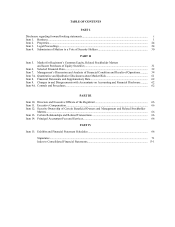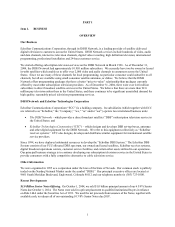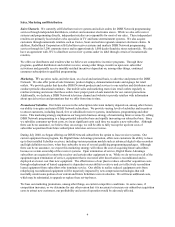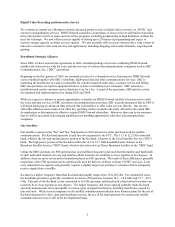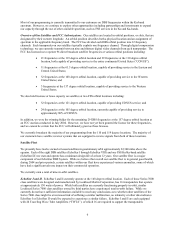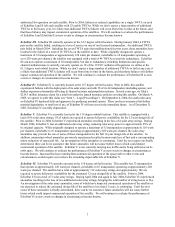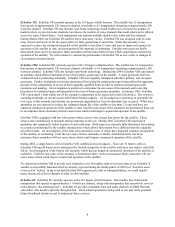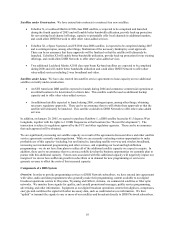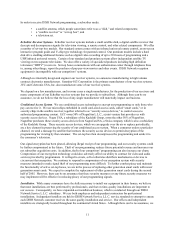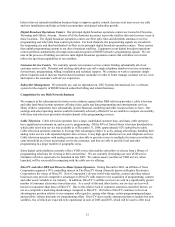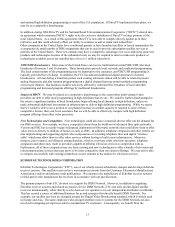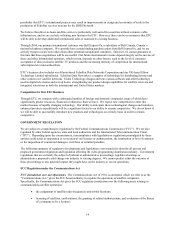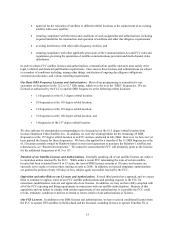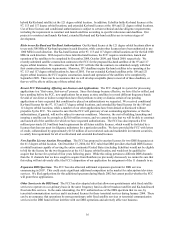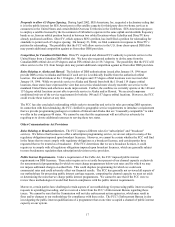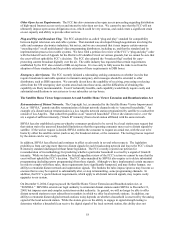Dish Network 2004 Annual Report Download - page 16
Download and view the complete annual report
Please find page 16 of the 2004 Dish Network annual report below. You can navigate through the pages in the report by either clicking on the pages listed below, or by using the keyword search tool below to find specific information within the annual report.8
EchoStar VII. EchoStar VII currently operates at the 119 degree orbital location. This satellite has 32 transponders
that operate at approximately 120 watts per channel, switchable to 16 transponders operating at approximately 240
watts per channel. EchoStar VII also includes spot-beam technology which enables us to increase the number of
markets where we provide local channels, but reduces the number of video channels that could otherwise be offered
across the entire United States. Each transponder can transmit multiple digital video, audio and data channels.
During March 2004, our EchoStar VII satellite lost a solar array circuit. EchoStar VII was designed with 24 solar
array circuits and needs 23 for the spacecraft to be fully operational at end of life. While this anomaly is not
expected to reduce the estimated design life of the satellite to less than 12 years and has not impacted commercial
operation of the satellite to date, an investigation of the anomaly is continuing. Until the root causes are finally
determined, there can be no assurance future anomalies will not cause further losses which could impact commercial
operation of the satellite. We will continue to evaluate the performance of EchoStar VII as new events or changes in
circumstances become known.
EchoStar VIII. EchoStar VIII currently operates at the 110 degree orbital location. This satellite has 32 transponders
that operate at approximately 120 watts per channel, switchable to 16 transponders operating at approximately 240
watts per channel. EchoStar VIII also includes spot-beam technology. During June 2004, EchoStar VIII experienced
an anomaly which affected operation of one of the primary gyroscopes on the satellite. A spare gyroscope has been
switched in and is performing nominally. EchoStar VIII was originally configured with three primary, and one spare,
gyroscope. Further, an anomaly previously experienced has resulted in certain gyroscopes being utilized for aggregate
periods of time substantially in excess of their originally qualified limits in order to maintain nominal spacecraft
operations and pointing. An investigation is underway to determine the root cause of the anomaly and to develop
procedures for continued spacecraft operation in the event of future gyroscope anomalies. In January 2005, EchoStar
VIII experienced a fault within one of the computer components in the spacecraft control electronics. The system is
operating nominally on one processor with limited backup capacity. An investigation is underway to determine the
root cause of this anomaly and whether any permanent degradation or loss of redundancy has occurred. While these
anomalies are not expected to reduce the estimated design life of the satellite to less than 12 years and have not
impacted commercial operation of the satellite to date, until the root causes of the anomalies are determined, there can
be no assurance future anomalies will not cause losses which could impact commercial operation of the satellite.
EchoStar VIII is equipped with two solar arrays which convert solar energy into power for the satellite. Those
arrays rotate continuously to maintain optimal exposure to the sun. During 2003, EchoStar VIII experienced
anomalies that temporarily halted rotation of each solar array. Both arrays are currently fully functional, but rotating
in a mode recommended by the satellite manufacturer which allows full rotation but is different than the originally
prescribed mode. An investigation of the solar array anomalies, none of which have impacted commercial operation
of the satellite, is continuing. Until the root cause of these anomalies is finally determined, there can be no
assurance future anomalies will not cause losses which could impact commercial operation of the satellite.
During 2003, a single battery cell on EchoStar VIII exhibited reduced capacity. There are 72 battery cells on
EchoStar VIII and all loads can be maintained for the full design life of the satellite with up to two battery cells fully
failed. An investigation of the battery cell anomaly, which has not impacted commercial operation of the satellite, is
underway. Until the root cause of the anomaly is determined, there can be no assurance future anomalies will not
cause losses which could impact commercial operation of the satellite.
We depend on EchoStar VIII to provide local channels to over 40 markets until at least such time as our EchoStar X
satellite is successfully launched which is currently expected during the fourth quarter of 2005 (see “Satellites under
Construction” below). In the event that EchoStar VIII experienced a total or substantial failure, we could transfer
many, but not all, of those channels to other in-orbit satellites.
EchoStar IX. EchoStar IX currently operates at the 121 degree orbital location. This satellite has 32 Ku-band
transponders that operate at approximately 110 watts per channel, along with transponders that can provide services
in Ka-Band (a “Ka-band payload”). EchoStar IX provides expanded video and audio channels to DISH Network
subscribers who install a specially-designed dish. The Ka-band spectrum is being used to test and verify potential
future broadband initiatives and to implement those services.


